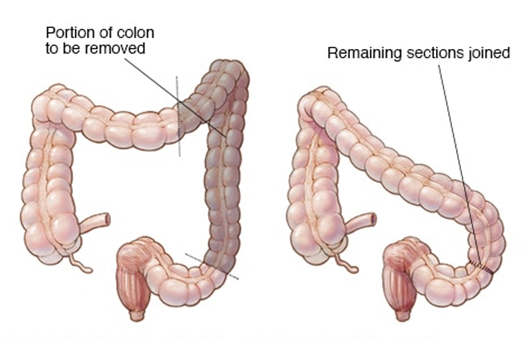Left Hemi-Colectomy

A left hemicolectomy is a surgical procedure to remove the left side of the colon, typically including the descending colon, a portion of the transverse colon, and sometimes part of the sigmoid colon. This left hemicolectomy procedure is performed to treat conditions such as colon cancer, diverticulitis, Crohn’s disease, or large polyps. Patients in need of a left hemicolectomy in Ahmedabad can rely on experienced surgeons for optimal outcomes.
Surgical Approaches
1. Open Left Hemi-Colectomy
Procedure:
- Incision: A large, vertical or transverse incision is made in the abdomen to access the colon during the left hemicolectomy operation.
- Exposure: The surgeon manually retracts tissues to expose the left side of the colon for the l hemicolectomy.
- Resection: The affected portion of the colon is identified, ligated, and removed along with associated blood vessels and lymph nodes.
- Anastomosis: The remaining ends of the colon are reconnected (anastomosed) to restore bowel continuity.
- Closure: The abdominal incision is closed with sutures or staples.
Advantages:
- Direct visualization and access to the colon during the left hemicolectomy procedure.
- Suitable for complex cases or when minimally invasive surgery is contraindicated, particularly in left hemicolectomy in Gujarat.
Disadvantages:
- Larger incision, leading to more pain and longer recovery.
- Higher risk of wound infection and hernia.
2. Laparoscopic Left Hemi-Colectomy
Procedure:
- Incisions: Several small incisions (ports) are made in the abdomen to insert a laparoscope (camera) and surgical instruments for the l hemicolectomy.
- Insufflation: The abdomen is inflated with carbon dioxide gas to create space for the surgery during the left hemicolectomy in Ahmedabad.
- Resection: Using the laparoscope, the surgeon visualizes the colon on a monitor and dissects the affected portion of the colon. Specialized instruments are used to ligate vessels and remove the colon.
- Anastomosis: The remaining ends of the colon are brought out through a small incision, connected, and reintroduced into the abdomen.
- Closure: The small incisions are closed with sutures or adhesive strips.
Advantages:
- Smaller incisions, resulting in less pain and scarring for patients undergoing a left hemicolectomy procedure.
- Faster recovery and shorter hospital stay.
- Reduced risk of infection and postoperative complications, making it a preferred choice for left hemicolectomy in Gujarat.
Disadvantages:
- Requires specialized skills and experience for the left hemicolectomy operation.
- May be challenging in patients with previous abdominal surgeries or significant adhesions.
3. Robotic Left Hemi-Colectomy
Procedure:
- Incisions: Similar to laparoscopic surgery, small incisions are made for the robotic arms and camera to perform the left hemicolectomy.
- Robotic System: The surgeon controls a robotic system from a console, which offers enhanced precision, dexterity, and 3D visualization, especially for best doctor for left hemicolectomy in Ahmedabad.
- Resection: The robotic arms, equipped with advanced instruments, are used to dissect and remove the affected portion of the colon.
- Anastomosis: The anastomosis is performed either robotically or with the assistance of a small incision.
- Closure: The incisions are closed similarly to laparoscopic surgery.
Advantages:
- Enhanced precision, reducing the risk of damage to surrounding tissues, provided by the best doctor for left hemicolectomy in Ahmedabad.
- Improved visualization with a 3D view.
- Greater dexterity, especially in difficult-to-reach areas.
Disadvantages:
- Requires access to robotic technology, which may not be available in all centers performing left hemicolectomy.
- Higher cost compared to traditional and laparoscopic surgery.
- Longer setup time for the robotic system.
Postoperative Care and Recovery
- Monitoring: Patients are closely monitored for complications such as infection, bleeding, or anastomotic leakage after the left hemicolectomy operation.
- Pain Management: Pain is managed with medications, which may vary depending on the surgical approach taken for l hemicolectomy.
- Diet: A gradual return to normal diet is recommended, starting with liquids and advancing to solids.
- Mobilization: Early mobilization is encouraged to reduce the risk of complications such as deep vein thrombosis (DVT) and pneumonia.
- Follow-up: Regular follow-up appointments are necessary to monitor recovery and detect any recurrence of disease.
Complications and Risks
- Infection: Higher risk in open surgery due to larger incisions, such as in the left hemicolectomy operation.
- Bleeding: Can occur during or after surgery.
- Anastomotic Leakage: A serious complication where the connection between the colon ends leaks.
- Hernia: Particularly in open surgery due to the large incision.
- Adhesions: Scar tissue that can form after surgery, potentially leading to bowel obstruction.